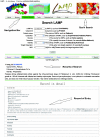LAMP: A Database Linking Antimicrobial Peptides
- PMID: 23825543
- PMCID: PMC3688957
- DOI: 10.1371/journal.pone.0066557
LAMP: A Database Linking Antimicrobial Peptides
Abstract
The frequent emergence of drug-resistant bacteria has created an urgent demand for new antimicrobial agents. Traditional methods of novel antibiotic development are almost obsolete. Antimicrobial peptides (AMPs) are now regarded as a potential solution to revive the traditional methods of antibiotic development, although, until now, many AMPs have failed in clinical trials. A comprehensive database of AMPs with information about their antimicrobial activity and cytotoxicity will help promote the process of finding novel AMPs with improved antimicrobial activity and reduced cytotoxicity and eventually accelerate the speed of translating the discovery of new AMPs into clinical or preclinical trials. LAMP, a database linking AMPs, serves as a tool to aid the discovery and design of AMPs as new antimicrobial agents. The current version of LAMP has 5,547 entries, comprising 3,904 natural AMPs and 1,643 synthetic peptides. The database can be queried using either simply keywords or combinatorial conditions searches. Equipped with the detailed antimicrobial activity and cytotoxicity data, the cross-linking and top similar AMPs functions implemented in LAMP will help enhance our current understanding of AMPs and this may speed up the development of new AMPs for medical applications. LAMP is freely available at: http://biotechlab.fudan.edu.cn/database/lamp.
Conflict of interest statement
Figures



References
-
- IDSA (2010) The 10×'20 Initiative: pursuing a global commitment to develop 10 new antibacterial drugs by 2020. Clin Infect Dis 50: 1081–1083. - PubMed
-
- Hancock RE, Sahl HG (2006) Antimicrobial and host-defense peptides as new anti-infective therapeutic strategies. Nat Biotechnol 24: 1551–1557. - PubMed
-
- Brogden KA (2005) Antimicrobial peptides: pore formers or metabolic inhibitors in bacteria? Nat Rev Microbiol 3: 238–250. - PubMed
-
- Zasloff M (2002) Antimicrobial peptides of multicellular organisms. Nature 415: 389–395. - PubMed
-
- Gallo RL, Murakami M, Ohtake T, Zaiou M (2002) Biology and clinical relevance of naturally occurring antimicrobial peptides. J Allergy Clin Immunol 110: 823–831. - PubMed
Publication types
MeSH terms
Substances
LinkOut - more resources
Full Text Sources
Other Literature Sources
Molecular Biology Databases

